This first week is due to see temperatures soaring here in Northern France. It's an explosive growth time, I submit some updates of how the small-holding is coming along, with a bit of a focus on our varied Kale beds... for Kristen. Freya and I couldn't spend too much time in the poly-tunnel, but you can see the tomatoes doing marvelously on the left and Kale on the right.
Lacinato Rainbow Kale
Halbhoher Kale
A mix of both Lacinato and Halbhoher Kale, so why the large amount of Kale you may be thinking, well that's a very good question. Kristen Beddard, the face, brains and driving force behind The Kale Project (http://thekaleproject.com/) found us, care of Olivier Cappaert, the face, brains and driving force behind Excuse My French (https://www.facebook.com/ExcuseMyFR). The project has a simple objective, "to bring the healthiest green vegetable to Paris".
True Siberian Kale
True Siberian
Red Ursa Kale
Red Ursa Kale
The nutrient values on this incredible super-food are simply staggering: in 100 grams of cooked, strained and unsalted Kale you will find (USDA recommended daily amount in parenthesis) Vitamin A (85%), Vitamin B1 (5%), Vitamin B2 (6%), Vitamin B3 (3%), Vitamin B6 (11%), Vitamin B9 (3%), Vitamin C (49%), Vitamin E (6%), Vitamin K (778%), Calcium (7%), Iron (7%), Magnesium (5%), Manganese (20%), Phosphorous (4%), Potassium (5%), Sodium (2%) and Zinc (3%)
Nero Di Toscano Kale
Delphinium
Foxglove
The clover is awash with countless bumble bees. The sound is so soothing, I honestly don't think I have ever seen so many chunky bumble bees in one spot.
A truly remarkable creature, we never get bored of watching, listening to or taking pictures of bees!
Strawberries a plenty too. This is the fifth straight day of picking them and we have been cropping pretty much this same amount daily... jealous much?
They say that you are what you eat, well Freya is aiming to become a massive juicy strawberry.
She is now starting to understand the seasonality of fruit and vegetables. We refuse to buy strawberries out of season, which is often hard to explain to 3-year old, but when there are more strawberries then this little one could possibly eat, she gets it and can look forward to natures bounty.





















































